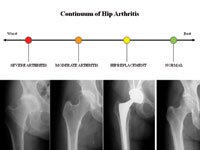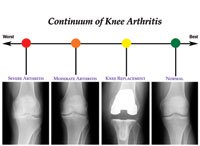Gauging patient satisfaction for total knee and hip arthroplasty
|
|
As with many medical procedures, the two primary components of patient satisfaction for total knee arthroplasty are patient expectations and outcomes.
“If we meet those expectations and concerns, our patients are more likely to be satisfied,” said Robert T. Trousdale, MD, a professor of orthopedic surgery at the Mayo Clinic. Likewise, if patients achieve “great motion with stability and a well-aligned limb, they are more likely to be satisfied with their outcome, as opposed to a stiff knee, a malaligned knee or an instable knee.”
Patient satisfaction
Trousdale reviewed two published studies that addressed patient satisfaction at the Current Concepts in Joint Replacement 2010 Winter Meeting. The first paper, from 1999, for which Trousdale was the principal investigator, identified the top six preoperative concerns (in descending order) of patients with knee and hip pain scheduled to undergoing total knee or hip replacement at the Mayo Clinic: postoperative pain level, length of recovery, ability to walk as much as desired, ability to return to recreational activities, ability to ascend and descend stairs, and the relative risk of acquiring HIV.
Older patients in general were less concerned than younger patients about pain after surgery, length of recovery and the joint wearing out during the patient’s lifetime.
The second study, published in 2010 from a group in Ontario, Canada, surveyed patients 1 year after their total knee or hip replacement. Hip patients were more likely to undergo surgery again (96%) than knee patients (89%). Hip patients also scored significantly higher on the WOMAC Index, their expectations were met more commonly and they had better overall total satisfaction.
“Perhaps we do better kinematically with hip replacement than with knee replacement,” Trousdale said. “The knees are more superficial joints and perhaps cause more pain than the deeper hip joints.”
The top three preoperative concerns of patients undergoing hip and knee replacement surgery are pain, length of recovery and overall function.
“It appears that total hip replacement is a slightly better and more reliable operation than for total knee, although both operations are very good,” Trousdale said.
Patient expectation
Trousdale also said that patient expectation probably correlates with satisfaction. For his total knee patients, Trousdale shares a diagram that shows a continuum of normal to abnormal knee(s).
“On the right is a normal knee, just slightly left of that is a perfect total knee replacement, a little left of that is moderate arthritis, and left of that is severe arthritis,” he said. “If someone comes in with moderate arthritis and they are crippled with knee pain, I tell that person we are not going to make your knee normal. We’re going to shift you to the right, but it is not going to be a normal knee.”
|
|
Images: Bos P |
Trousdale believes that some of his patients expect a total knee arthroplasty (TKA) to render a normal knee. “But none of us are able to provide that, of course, for our patients,” he said.
The diagram is also shared with patients who have had TKA, but are not doing as well as they expected.
“I have found the graph very helpful in patient discussions,” Trousdale said. – by Bob Kronemyer
Reference:
- Trousdale RT. Patient satisfaction: I never promised you a rose garden. Paper #95. Presented at the Current Concepts in Joint Replacement 2010 Winter Meeting. Dec. 8-11, 2010. Orlando, Fla.
- Robert T. Trousdale, MD, can be reached at Mayo Clinic, 200 First St. SW E14B, Rochester, MN 55905; 507-284-3663; email: trousdale.robert@mayo.edu.
- Disclosure: Trousdale receives royalties from DePuy, a Johnson and Johnson Company, MAKO Surgical Corp. and Ortho Development.



